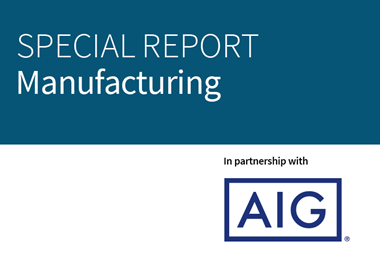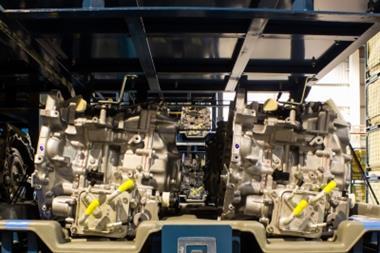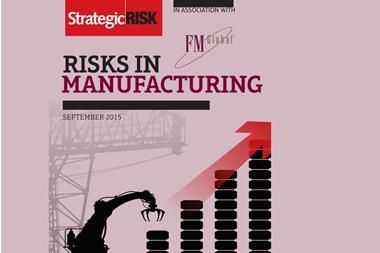The biggest change to production processes in almost two centuries offers unprecedented opportunities but companies must balance these against a complex downside

The most significant and fundamental advance in manufacturing since the original Industrial Revolution more than 200 years ago is radically transforming the sector in a way that was unthinkable even a decade ago.
Industry 4.0, also known as Manufacturing 4.0, is the fourth major change in mechanised production since steam power and offers businesses extraordinary flexibility and efficiencies through smart working practices.
Defining the concept in precise terms is difficult. There are several perspectives on what exactly 4.0 is and what it means. In essence this is a marriage of cyber physical systems [engineered mechanisms monitored or controlled by computational algorithm] working and communicating between themselves and human operators with everything and everyone connected via the Internet of Things and/or the Cloud.
Perhaps the most significant aspect of the 4.0 interface dynamic between people and intelligent machines is the decentralised decision-making process which is undertaken by the cyber physical systems themselves so they can be fully autonomous, unless in exceptional circumstances.
Whereas earlier industrial revolutions affected physical processes, people were still the decision makers. With 4.0 people ultimately remain in overall control but localised decisions are made by machines which learn and adapt. Just as the mechanisation of physical processes means fewer people working on a factory floor, 4.0 removes another layer of human involvement.
The motor industry, which led the way with first-generation mechanised robotic production back in the late 1970s and 1980s, is already embracing 4.0, albeit in a piecemeal and iterative way. Audi’s tool-making division has reportedly developed self-learning technology for certain production operations. It is also using so-called helper robots for car assembly – a process being introduced by other major auto manufacturers.
Wholesale change through purpose-built production facilities is happening but most developments are being introduced gradually across this and other manufacturing areas.
Steel maker ArcelorMittal is one such business where 4.0 is starting to get traction, according to its corporate operational risk manager Adrian Clements. However, the fundamental issues of how, where and when are dependent on the maturity of individual production sites.
“We have plants in Kazakhstan which are very robust but are also very manual,” he says. “You need thousands of workers, there is very little automation and these are basic in the way they operate, so you can forget 4.0 for them.
“Then you have other plants such as the one we have in Ghent, Belgium, which are much more sophisticated.” This, he says, makes 4.0 easier to implement.
Smart factory
Fredrik Motzfeldt, GB industry leader, technology, media & telecommunications at Willis Towers Watson, and a specialist in 4.0 risk, highlights a further problem.
“Some of the newer stuff that is being built is being designed as a smart factory from the beginning,” he says. “You look at traditional industries such as the power industry however and they have created vulnerabilities by building smart infrastructure on top of what is traditional infrastructure. Some of the industrial control systems were never meant to be connected to the internet.”
Such exposure increases the risk of cyber-related threats which could seriously damage production.
Nonetheless, the range of possibilities promised by 4.0 means companies are examining its deployment carefully. “We are already testing something in this direction,” says Clements. “Our maintenance people wear helmets and we are testing a version with a headup display so that when they look at a pump or transformer it automatically searches through the database, finds the drawings, finds the instructions for how to take it apart, so that the maintenance people are able to work on the equipment properly. The aim is to reduce errors by people not knowing what to do.”
However, there are also issues. Total uninterrupted connectivity is required which is not always straightforward in a large volume steel plant “producing lots of electro-magnetic emissions”.
Further, Clements says, the technology is only as useful as the data it is given. “In the worst case, relying on [out of date] data could mean doing something wrong.”
Hans Læssøe, senior director, strategic risk management at toy manufacturer LEGO Group, has seen plenty of changes to the production process in his 35 years with the business.
For a company which produces 2300 bricks per second, any break in schedule no matter how short, is significant and this is where 4.0 advances can be especially effective. New automated technology means producers such as LEGO can ensure efficiency optimisation with less time lost to quality issues or slowdowns.
Læssøe says 4.0 was being undertaken on an “ongoing basis”. “We are upgrading our moulding machines, we are enhancing our technology and improving our equipment for packing lines. We are undertaking a project which is examining analytics to predict when our moulding machines might stop so that they don’t stop at all.”
In addition to minimising downtime, 4.0 also offers LEGO the opportunity to minimise other potential production issues caused by the supply chain.
“In terms of the material we use [for moulding bricks] there could be differences in the granularity, the structure, humidity and so on. There can be temperature and air pressure changes – a tonne of differences that can have an impact on the final element. We are using technology to create a process which takes as much variety as there can be from all these factors that we cannot change and still come up with a brick that lives up to our specifications. If you can do that then you will have a much bigger success rate.”
Monitoring the entire production process should also be much easier and can be done remotely, according to Motzfeldt.
“The whole idea of 4.0 is that you can run a factory from somebody’s iPad,” he says. “Move forward 10 years from now and we will see complete automation of some industries… these will be run by a very small crew, almost like a nuclear power plant.”
Motzfeldt warns that while 4.0 is developing very quickly it is easy to miss the broader implications and risks in the race to maximise the advantages it offers.
“A manufacturer may well think that 4.0 is a great idea… but they haven’t really thought about what the vulnerabilities are by connecting all of these systems.”
Aside from concerns around technology exposure, the social and societal impact of 4.0 could be the biggest single risk.
“I don’t think there is any doubt that robotics and automation is going to come in very heavily and we may not end up working much at all,” Motzfeldt says.
Efficiency optimisation
While traditional roles might disappear, Motzfedt says 4.0 will also create new jobs but the process needs to be managed carefully: “You need a strategy that goes from kindergarten to primary, to high school and up into the workforce – so you can get the right engineers, the right type of people. This will create a whole economy around cyberphysical expertise.”
In the meantime, there is plenty of work to be done managing the risks of 4.0 so that the opportunities outweigh the threats and benefits are maximised in a realistic way.
“I don’t think some companies have a good enough idea of what they are getting themselves into,” says Motzfedt. “They feel the benefit – the efficiencies of the process, the fact it will be easy to run things at lower cost, but they don’t look at exactly what they are doing.”




















No comments yet